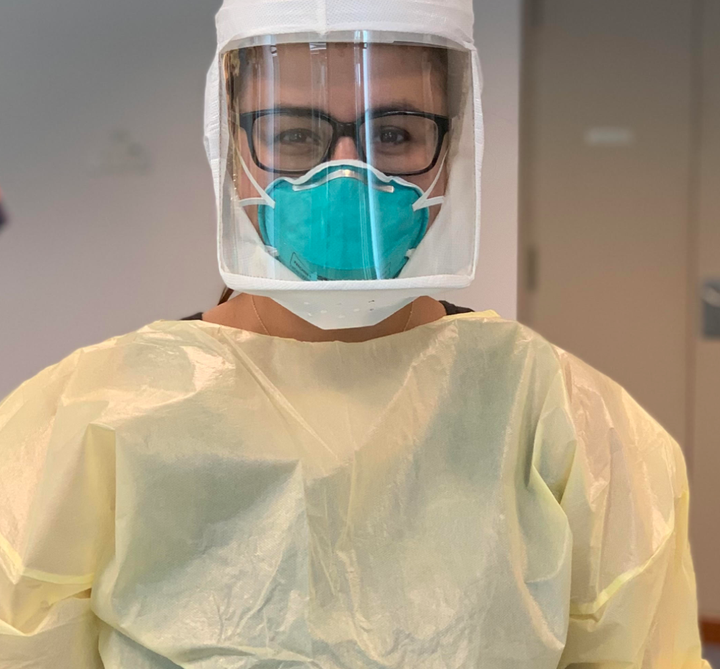
My job as a public health physician is to protect your family from COVID-19 — and I should have been able to protect my own. Studying this novel virus and educating the public about it has consumed my days since early 2020, which made it especially troubling when my husband, my son and I contracted the Delta variant of COVID-19 last month.
In December 2019, I was working as the director of infection prevention at a large academic health system in Singapore. On New Year’s Eve, while most of the world remained unaware of the looming danger, I learned about a new respiratory syndrome from my emerging infectious disease network. We were hearing troubling news about the syndrome and began safety preparations at the hospital in January 2020, while we were also struggling to understand more about it.
In the hospital, we used strict infection prevention protocols (you can read more about them here and here) to prevent transmission. We opened an emergency department for suspected COVID-19 cases in an open-air tent, without high-tech air handling systems. Despite seeing thousands of patients there, we had no transmission of the virus among any of our staff.
When I moved back to the United States in July 2020, I started a new public health role where my priority was COVID-19 testing and prevention. I’ve authored academic papers on COVID-19, and I’ve consulted for international public health agencies. It’s safe to say that since the beginning of 2020, COVID-19 has been the focus of my professional life.
I use the same infection prevention measures that I advise to the public in my personal life. For more than a year, I have not done things that I consider moderate to high risk, including traveling by air, eating at indoor restaurants, attending indoor concerts or visiting movie theaters or gyms. My husband and I were vaccinated as soon as we were eligible, we avoided large gatherings and we continued to wear face masks in indoor public spaces even after the Centers for Disease Control and Prevention (CDC) relaxed mask recommendations for fully vaccinated people in May.
Despite our family’s precautions, my 7-year-old son (I’ll refer to him as B.B.) was exposed to the virus through an outbreak at his outdoor day camp, which should have been a lower risk setting. He wore a mask whenever possible. We did not take unnecessary risks, and yet here we are.
So why was I unable to protect my own family? The reasons should concern you.
1) Working parents like me need child care.
Working parents, like me and my husband, need child care even when work is mostly remote. After a full year of virtual school, I wanted B.B. to be around children his age. We understood that this was a calculated risk ― one that we were willing to take given all the other precautions in our lives. We enrolled him in an outdoor day camp where he underwent daily symptom checks at drop-off.
We know that people who are asymptomatic can transmit the virus that causes COVID-19 and that children may have few symptoms. This means measures such as symptom screenings and temperature checks at camps and day cares can be less effective. Parents with few child care options may be tempted to drop their kids off even if they have been exposed to COVID-19 or have mild symptoms, like a runny nose. But unless we identify all asymptomatic “silent” cases of COVID-19 in children, it will be nearly impossible to prevent outbreaks.
The routine use of rapid antigen tests for the virus has been one way to identify early or asymptomatic infections in school-aged children, and even though these tests are now widely available in the area we live in, routine testing was not in place at my son’s camp.
2) Universal masking is the best protection, but it’s no longer mandated in many arenas.
I had hoped that an outdoor camp — where children would be wearing face masks in indoor spaces and counselors would be wearing them at all times — would be relatively low risk. I took comfort in the infection control measures outlined in camp introductory materials. When I dropped B.B. off for his first day of camp, the counselors wore masks. But by the end of the first week, this had stopped, and B.B. told me that counselors and campers often removed their masks indoors.
Masks are fantastic tools for preventing transmission of virus, but they are most effective when both infected and susceptible individuals wear them. By wearing a mask, B.B. was doing a great job at protecting other campers, but the other campers and counselors weren’t offering him the same consideration.
When the CDC released its recommendations in May advising that fully vaccinated individuals no longer needed to wear masks, many of my public health colleagues were perplexed for a couple of reasons: It is hard to tell who is vaccinated and who is not, and we know that vaccine “breakthrough” infections can occur (more about that later).
Not wearing a mask may not personally affect a fully vaccinated, healthy adult. But the decision to stop requiring masks in public spaces creates an unsafe environment for those who are most vulnerable: those who are immunocompromised and people who are ineligible to receive the vaccine, either due to age or an underlying medical condition.
3) Transmission is difficult to prevent between household members.
We had no warning that B.B. had been exposed to COVID-19. When he developed a high fever, I tested him using a rapid home COVID-19 antigen test and then called the local health department. Had B.B. been under quarantine from the time of his exposure, we could have worn masks at home and taken extra precautions. As it was, without notification, my husband and I were likely exposed to high levels of the coronavirus in the days preceding B.B.’s symptoms.
Even if we had known about the exposure, we might not have been able to avoid household transmission. It is exceedingly difficult to parent a sick child without exposing yourself. Young children are less able to adhere to infection control measures such as disposing contaminated tissues safely or washing their hands thoroughly. Once a child brings home COVID-19, the risk to other household members is present even when families attempt to distance.
4) The delta variant is here and that changes everything.
When the CDC relaxed mask recommendations for fully vaccinated people in May, it was counting on the remarkable efficacy of vaccines. Vaccines remain the single best tool we have against COVID-19, especially against severe illness, hospitalization and death, even in the presence of emerging variants.
However, when the guidance was issued, things were not looking so rosy around the world, leaving many of us in public health scratching our heads about the timing. The delta variant had already wreaked havoc in India, and early reports from the United Kingdom had signaled that the variant was more transmissible and caused infections in vaccinated people (aka “breakthrough infections”).
We now have data to suggest that the delta variant (when compared to the original strain of the virus) is up to twice as transmissible and the amount of detectable virus in infected individuals is much higher. While the currently available vaccines still offer good protection against the delta variant, efficacy may be somewhat reduced, and it is likely that people with breakthrough infections can transmit the virus to others.
The delta variant will not be the last COVID-19 variant we see. New mutations will arise as long as the coronavirus continues to spread, and the lambda variant is already causing fresh concerns. The next variant may be more transmissible, deadlier, better able to evade vaccines, or a combination of these factors.
Where do we go from here?
The pandemic is far from over, and our only hope for moving into the fall with any degree of normalcy is to better protect unvaccinated kids under 12. Families cannot do this alone, and we need a set of community safeguards.
These safeguards include universal masking (for both vaccinated and unvaccinated people) in schools, camps, day cares and other settings where children spend their time, and ensuring that teachers and staffers are vaccinated. We need regular testing programs for asymptomatic children in these settings and better support for parents caring for sick children. We need to continue robust contact tracing and quarantining after exposure in the community, including exposure in schools, camps and day cares.
Public health professionals like me know how to prevent COVID-19 transmission. Now, we need communities and individuals to follow our guidance. I could not guarantee the safety of my family because implementing these simple safeguards requires a social contract ― a societal agreement to cooperate in order to protect the health and safety of our children, even if it inconveniences us or requires compromise.
As new variants emerge, we will need to reevaluate the risk of transmission from outdoor contact, from fleeting contact, and from vaccinated individuals.
We will need to reevaluate the way we think about breakthrough infections among those who are vaccinated. Both my husband and I (relatively healthy and in our mid 40s) had fevers, chills, headaches, coughs and shortness of breath. While breakthrough infections tend to be less severe than infections among those who are unvaccinated, this does not mean that all breakthrough infections are mild or that they don’t cause distress and disruption for those affected.
Pediatric COVID-19 infections are also typically thought of as mild but B.B. had fevers for over a week and required an emergency department visit, where he underwent a blood draw, a chest X-ray and an electrocardiogram. More than 4,000 children in the U.S. have developed multisystem inflammatory syndrome, a rare but serious condition associated with COVID-19, which can be life-threatening.
Unvaccinated people keep community transmission going and provide a reservoir for the virus to continue to mutate. While many people are unvaccinated by choice, we must prioritize and protect those who are unvaccinated due to their age or underlying medical conditions. As a society, we have a responsibility to prevent suffering for those most vulnerable among us. By protecting our children, we will not only prevent severe pediatric complications, but we’ll also protect families and entire communities.
Note: The views expressed in the author’s work are solely hers and do not represent the views of any organization or entity with which she is affiliated.
Natasha Bagdasarian, M.D., M.P.H., is an infectious disease physician and epidemiologist. She lives in Michigan and works on the COVID-19 public health response, specifically in the areas of testing and infection prevention in vulnerable settings. For more from her, follow her on Twitter at @nnbagdasarian.
Do you have a compelling personal story you’d like to see published on HuffPost? Find out what we’re looking for here and send us a pitch.
